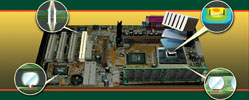

Reliability: there is no higher calling for today’s electronics assemblies. The newest generation of portable gaming devices, PDAs, mobile phones, laptops, and MP3 players are just a few of the products that consumers are clamouring for, and with that comes an ever-higher demand for product reliability.
Add to that the implementation of RoHS, requiring the transition to Pb-free assembly materials, and the challenge is clear: optimise Pb-Free assembly technology to produce more efficient, functional, and reliable products that meet both marketplace and regulatory requirements.
In the area of performance, Pb-free solder joints can be more brittle than SnPb. Coupled with the fact that solder joints are getting smaller and are running hotter, we have got ourselves a challenge. When we talk about process, solder paste viscosity, stencil life, response-to-pause printing, and the reflow process, they are all different when using a Pb-Free product. These issues have driven the development of new Pb-Free assembly technologies.
Today's highest reliability products implement the latest in materials and assembly technology, including: no-flow underfill to enhance the reliability of BGA/CSP components, solder reinforcement solutions at high stress locations, advanced thermal interface materials to more effectively remove the heat from components and process changes to accommodate the new Pb-Free alloys.
Considerations
* Improve reliability of solder joints with the use of underfills: Sn/Ag/Cu (SAC) solders are harder and more creep-resistant than Sn/Pb solders. This means they can be more prone to brittle fractures. To enhance the reliability of solder joints, many are considering the use of reworkable, air-reflowable, no-flow underfills. These products offer significantly higher reliability versus solder alone. Underfills address the challenges of brittle Pb-Free alloys, portability, and miniaturisation, by resulting in fewer field failures.
* Minimise voiding with new solder paste technology: Pb-free solder pastes generally have an increased tendency to produce voids in solder joints due to the alloys' higher melting and reflow temperatures, as well as the higher surface tension of the molten Pb-Free solder. While higher voiding does not directly translate to lower solder joint reliability, assemblers generally are more comfortable with low-voiding under BGA components. New solder paste technologies address this voiding issue. These products offer excellent response-to-pause printability, deliver excellent wetting to all common Pb-Free metallisations, offer reduced voiding across a wide variety of reflow profiles, and provide unsurpassed print transfer efficiency through small apertures. Modern solder pastes truly do contribute to reduced voiding.
* Increase reliability of thermal interface materials: for thermal issues, thermal interface materials (TIMs) are used to efficiently transmit heat from an area of high thermal energy to an area of lower thermal energy. These materials are used to conduct heat away from a temperature sensitive device, or to transmit thermal energy to a device that is being thermally tested. More efficient thermal interface materials enable the cooling of higher power devices.
* Adjust reflow profile to counter tombstoning: wetting speed of the alloy being used and thermal gradient across the board are the two primary causes for tombstoning of small passive components. Since Pb-free alloys melt at a higher temperature, the board being assembled is likely to have a greater thermal gradient and could be more prone to tombstoning. By adjusting the reflow profile and identifying the correct products, one can reduce tombstoning.
Solutions
The need to support smaller, more powerful products while complying with RoHS has changed the assembly industry. While a thorough evaluation of all current processes should occur to evaluate the alloys and processes being used, there is whole new class of solders and materials developed to meet the demand and support finished good reliability.
Indium Corporation is a four-time Frost & Sullivan award-winning supplier of electronics assembly materials, including solder pastes, solder preforms, fluxes, Pb-free solder alloys, underfill materials, die-attach materials, and more. The ISO-9001 registered company is also a premiere supplier of commercial grade and high-purity indium.

© Technews Publishing (Pty) Ltd | All Rights Reserved